 W
WThe Aerial Reconfigurable Embedded System (ARES) was a concept for an unmanned VTOL flight module that can transport various payloads. The concept started as the TX (Transformer) in 2009 for a terrain-independent transportation system centered on a ground vehicle that could be configured into a VTOL air vehicle and carry four troops. ARES' primary function was the same as TX, to use flight to avoid ground-based transportation threats like ambushes and IEDs for units that don't have helicopters for those missions. It was to be powered by twin tilting ducted fans and have its own power system, fuel, digital flight controls, and remote command-and-control interfaces. The flight module would have different detachable mission modules for specific purposes including cargo delivery, CASEVAC, and ISR. Up to 3,000 lb (1,400 kg) of payload would be carried by a module.
 W
WThe ASW Continuous Trail Unmanned Vessel (ACTUV) is a DARPA funded project launched in early 2010 to develop an anti-submarine drone. ASW is an acronym for Anti-Submarine Warfare. In January 2018 after successful sea trials it was announced that the "Sea Hunter" prototype has transitioned from DARPA to the Office of Naval Research for further development.
 W
WBigDog is a dynamically stable quadruped military robot that was created in 2005 by Boston Dynamics with Foster-Miller, the NASA Jet Propulsion Laboratory, and the Harvard University Concord Field Station. It was funded by DARPA, but the project was shelved after the BigDog was deemed too loud for combat.
 W
WBoomerang is a gunfire locator developed by DARPA and BBN Technologies primarily for use against snipers. Boomerang is mounted on mobile vehicles such as the Humvee, Stryker, and MRAP combat vehicles. There were plans to integrate it into the Land Warrior system.
 W
WCatcher's Mitt is the name of a study conducted by the United States Defense Advanced Research Projects Agency (DARPA) to "better understand the issues and challenges involved with removing man-made debris from earth orbit." DARPA's goal was to use the study to determine both if DARPA should invest more resources in orbital debris removal and, if so, how to best do so.
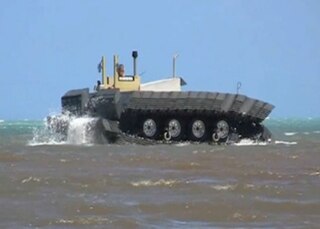 W
WThe Captive Air Amphibious Transporter (CAAT) is a 1:5 scale tracked amphibious vehicle prototype being developed by DARPA. It drives on the water with air-filled pontoons attached to the tracks, and is intended to demonstrate how to transport standard 20- or 40-foot containers from ordinary container ships to shore without using a harbor. DARPA is investigating its usefulness in disasters so that commercial shipping can relieve military ships to focus on military tasks. The CAAT is one of four elements in the Tactically Expandable Maritime Platform (TEMP) program; the others being a containerized living quarter, a stabilized crane, and an unmanned powered parachute delivering containers by air.
 W
WThe DARPA Falcon Project is a two-part joint project between the Defense Advanced Research Projects Agency (DARPA) and the United States Air Force (USAF) and is part of Prompt Global Strike. One part of the program aims to develop a reusable, rapid-strike Hypersonic Weapon System (HWS), now retitled the Hypersonic Cruise Vehicle (HCV), and the other is for the development of a launch system capable of accelerating an HCV to cruise speeds, as well as launching small satellites into Earth orbit. This two-part program was announced in 2003 and continued into 2006.
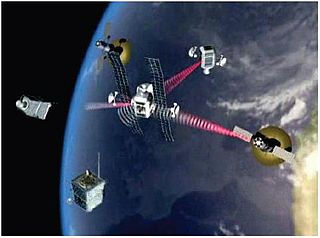 W
WA fractionated spacecraft is a satellite architecture where the functional capabilities of a conventional monolithic spacecraft are distributed across multiple modules which interact through wireless links. Unlike other aggregations of spacecraft, such as constellations and clusters, the modules of a fractionated spacecraft are largely heterogeneous and perform distinct functions corresponding, for instance, to the various subsystem elements of a traditional satellite.
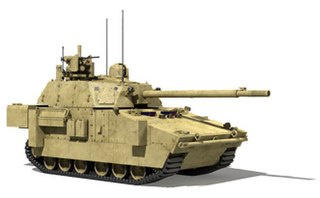 W
WThe Future Combat Systems Manned Ground Vehicles (MGV) was a family of lighter and more transportable ground vehicles developed by BAE Systems Inc and General Dynamics as part of the United States Army's Future Combat Systems (FCS) program. The ground vehicles were to be based on a common tracked vehicle chassis. The MGV program was superseded by the Ground Combat Vehicle which has also been cancelled.
 W
WThe GBA-DARPA Heliplane was a proof-of-concept, long-range, VTOL aircraft intended to cruise at twice the speed of conventional helicopters. It was funded by the Defense Advanced Research Projects Agency (DARPA) and designed by Groen Brothers Aviation (GBA), which has since been re-branded as Skyworks Global.
 W
WThe Integrated Sensor is Structure (ISIS) was a program managed by the United States Air Force (USAF) Research Laboratory to research the feasibility of using an unmanned airship as a high-altitude aerial reconnaissance and surveillance platform. It is sometimes called Integrated Sensor is the Structure, as a fundamental innovation was the use of the airship structure as the sensing component of a state-of-the-art radar system.
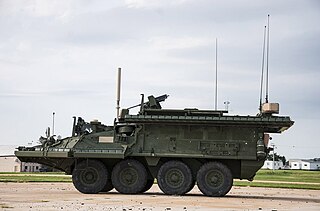 W
WIron Curtain is an active protection system (APS) designed by Artis, an American technology development and manufacturing firm. The system is designed to protect military vehicles and other assets by intercepting threats such as rocket-propelled grenades and other shoulder-launched missiles and rendering them inert.
 W
WThe Legged Squad Support System (LS3) was a DARPA project for a legged robot which could function autonomously as a packhorse for a squad of soldiers or marines. Like BigDog, its quadruped predecessor, the LS3 was ruggedized for military use, with the ability to operate in hot, cold, wet, and dirty environments. The LS3 was put into storage in late 2015.
 W
WTactically Exploited Reconnaissance Node (TERN), a joint program between DARPA and the U.S. Navy's Office of Naval Research (ONR), seeks to greatly increase the effectiveness of forward-deployed small-deck ships such as destroyers and frigates by enabling them to serve as mobile launch and recovery sites for specially designed unmanned aerial systems (UAS). These vehicles are to carry 600 pounds of ordnance in order to conduct combat strikes.
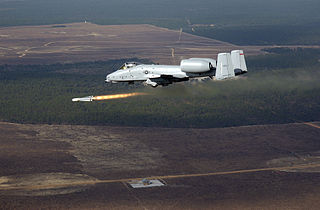 W
WPersistent Close Air Support (PCAS) is a DARPA program that seeks to demonstrate dramatic improvements in close air support (CAS) capabilities by developing a system to allow continuous CAS availability and lethality to Joint Terminal Attack Controllers (JTACs).
 W
WQuantum Entanglement Science and Technology (QuEST) is a research program, announced by the DARPA Microsystems Technology Office (MTO) in 2008. As a follow-on to the QuIST Program, its goal was to further accelerate development in the field of quantum information science.
 W
WThe Quantum Information Science and Technology Program was a five-year, $100M DARPA research program that ran from FY 2001 – 2005. The initiative was jointly created by the Defense Sciences Office (DSO) and the Information Technology Office (ITO) to accelerate development in the field of quantum computing, quantum communications, quantum algorithms, and other high-priority quantum information applications. As a completed program, QuIST received an award from DARPA in 2008 for scientific breakthroughs previously conducted under its support.
 W
WSea Hunter is an autonomous unmanned surface vehicle (USV) launched in 2016 as part of the DARPA Anti-Submarine Warfare Continuous Trail Unmanned Vessel (ACTUV) program. She was christened 7 April 2016 in Portland, Oregon. She was built by Vigor Industrial. The vessel continues the line of experimental "Sea" ships, including Sea Shadow, Sea Fighter, Sea Jet, and Sea Slice. Sea Hunter is classified as a Class III USV and designated the Medium Displacement Unmanned Surface Vehicle (MDUSV).
 W
WSyNAPSE is a DARPA program that aims to develop electronic neuromorphic machine technology, an attempt to build a new kind of cognitive computer with form, function, and architecture similar to the mammalian brain. Such artificial brains would be used in robots whose intelligence would scale with the size of the neural system in terms of total number of neurons and synapses and their connectivity.
 W
WThe Vertical Take-Off and Landing Experimental Aircraft program is an American research project sponsored by the Defense Advanced Research Projects Agency (DARPA). The goal of the program is to demonstrate a VTOL aircraft design that can take off vertically and efficiently hover, while flying faster than conventional rotorcraft. There have been many previous attempts, most of them unsuccessful.
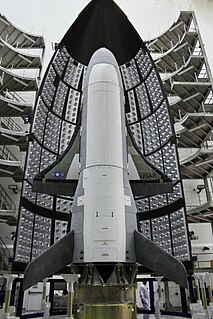 W
WThe Boeing X-37, also known as the Orbital Test Vehicle (OTV), is a reusable robotic spacecraft. It is boosted into space by a launch vehicle, then re-enters Earth's atmosphere and lands as a spaceplane. The X-37 is operated by the United States Space Force for orbital spaceflight missions intended to demonstrate reusable space technologies. It is a 120-percent-scaled derivative of the earlier Boeing X-40. The X-37 began as a NASA project in 1999, before being transferred to the United States Department of Defense in 2004.